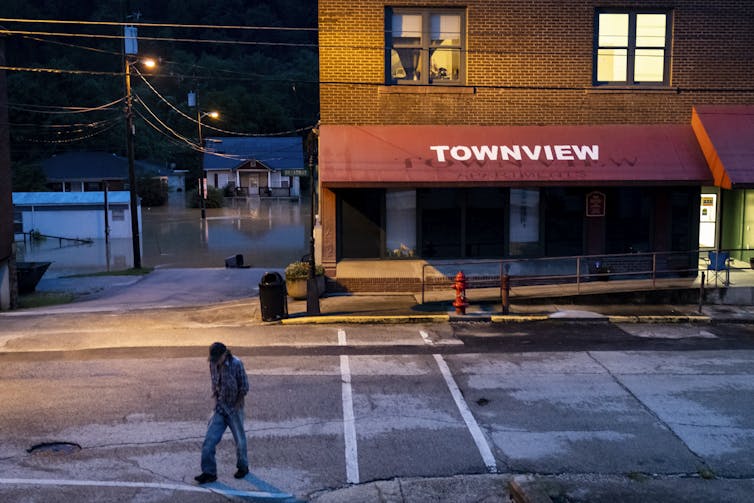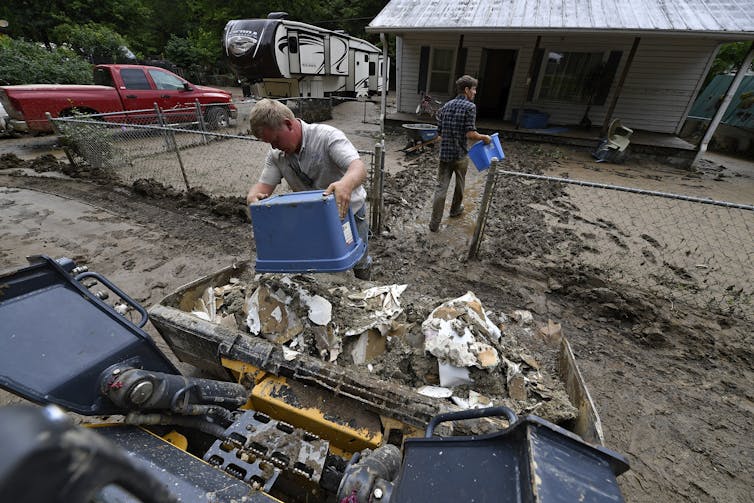
Arden S. Barnes/For The Washington Post via Getty Images
On Valentine’s Day 2025, heavy rains started to fall in parts of rural Appalachia. Over the course of a few days, residents in eastern Kentucky watched as river levels rose and surpassed flood levels. Emergency teams conducted over 1,000 water rescues. Hundreds, if not thousands of people were displaced from homes, and entire business districts filled with mud.
For some, it was the third time in just four years that their homes had flooded, and the process of disposing of destroyed furniture, cleaning out the muck and starting anew is beginning again.
Historic floods wiped out businesses and homes in eastern Kentucky in February 2021, July 2022 and now February 2025. An even greater scale of destruction hit eastern Tennessee and western North Carolina in September 2024, when Hurricane Helene’s rainfall and flooding decimated towns and washed out parts of major highways.

Each of these events was considered to be a “thousand-year flood,” with a 1-in-1,000 chance of happening in a given year. Yet they’re happening more often.
The floods have highlighted the resilience of local people to work together for collective survival in rural Appalachia. But they have also exposed the deep vulnerability of communities, many of which are located along creeks at the base of hills and mountains with poor emergency warning systems. As short-term cleanup leads to long-term recovery efforts, residents can face daunting barriers that leave many facing the same flood risks over and over again.
Exposing a housing crisis
For the past nine years, I have been conducting research on rural health and poverty in Appalachia. It’s a complex region often painted in broad brushstrokes that miss the geographic, socioeconomic and ideological diversity it holds.
Appalachia is home to a vibrant culture, a fierce sense of pride and a strong sense of love. But it is also marked by the omnipresent backdrop of a declining coal industry.
There is considerable local inequality that is often overlooked in a region portrayed as one-dimensional. Poverty levels are indeed high. In Perry County, Kentucky, where one of eastern Kentucky’s larger cities, Hazard, is located, nearly 30% of the population lives under the federal poverty line. But the average income of the top 1% of workers in Perry County is nearly US$470,000 – 17 times more than the average income of the remaining 99%.
This income and wealth inequality translates to unequal land ownership – much of eastern Kentucky’s most desirable land remains in the hands of corporations and families with great generational wealth.
When I first moved to eastern Kentucky in 2016, I was struck by the grave lack of affordable, quality housing. I met families paying $200-$300 a month for a small plot to put a mobile home. Others lived in “found housing” – often-distressed properties owned by family members. They had no lease, no equity and no insurance. They had a place to lay one’s head but lacked long-term stability in the event of disagreement or disaster. This reality was rarely acknowledged by local and state governments.
Eastern Kentucky’s 2021 and 2022 floods turned this into a full-blown housing crisis, with 9,000 homes damaged or destroyed in the 2022 flood alone.
“There was no empty housing or empty places for housing,” one resident involved in local flood recovery efforts told me. “It just was complete disaster because people just didn’t have a place to go.”
Most homeowners did not have flood insurance to assist with rebuilding costs. While many applied to the Federal Emergency Management Agency for assistance, the amounts they received often did not go far. The maximum aid for temporary housing assistance and repairs is $42,500, plus up to an additional $42,500 for other needs related to the disaster.
The federal government often provides more aid for rebuilding through block grants directed to local and state governments, but that money requires congressional approval and can take months to years to arrive. Local community coalitions and organizations stepped in to fill these gaps, but they did not necessarily have sufficient donations or resources to help such large numbers of displaced people.

Michael Swensen/Getty Images
With a dearth of affordable rentals pre-flood, renters who lost their homes had no place to go. And those living in “found housing” that was destroyed were not eligible for federal support for rebuilding.
The sheer level of devastation also posed challenges. One health care professional told me: “In Appalachia, the way it usually works is if you lose your house or something happens, then you go stay with your brother or your mom or your cousin. … But everybody’s mom and brother and cousin also lost their house. There was nowhere to stay.” From her point of view, “our homelessness just skyrocketed.”
The cost of land – social and economic
After the 2022 flood, the Kentucky Department for Local Government earmarked almost $300 million of federal funding to build new, flood-resilient homes in eastern Kentucky. Yet the question of where to build remained. As another resident involved in local flood recovery efforts told me, “You can give us all the money you want; we don’t have any place to build the house.”
It has always been costly and time-intensive to develop land in Appalachia. Available higher ground tends to be located on former strip mines, and these reclaimed lands require careful geotechnical surveying and sometimes structural reinforcements.
If these areas are remote, the costs of running electric, water and other infrastructure services can also be prohibitive. For this reason, for-profit developers have largely avoided many counties in the region. The head of a nonprofit agency explained to me that, because of this, “The markets have broken. … We have no [housing] market.”

Posnov/Moment via Getty Images
There is also some risk involved in attempting to build homes on new land that has not previously been developed. A local government could pay for undeveloped land to be surveyed and prepared for development, with the prospect of reimbursement by the U.S. Department of Housing and Urban Development if housing is successfully built. But if, after the work to prepare the land, it is still too cost-prohibitive to build a profitable house there, the local government would not receive any reimbursement.
Some counties have found success clearing land for large developments on former strip mine sites. But these former coal mining areas can be considerable distances from towns. Without robust public transportation systems, these distances are especially prohibitive for residents who lack reliable personal transportation.
Another barrier is the high prices that both individual and corporate landowners are asking for properties on higher ground.
The scarcity of desirable land available for sale, combined with increasingly urgent demand, has led to prices unaffordable for most. Another resident involved in local flood recovery efforts explained: “If you paid $5,000 for 30 acres 40 years ago, why won’t you sell that for $100,000? Nope, [they want] $1 million.” That makes it increasingly difficult for both individuals and housing developers to purchase land and build.
One reason for this scarcity is the amount of land that is still owned by outside corporate interests. For example, Kentucky River Properties, formerly Kentucky River Coal Corporation, owns over 270,000 acres across seven counties in the region. While this landholding company leases land to coal, timber and gas companies, it and others like it rarely permit residential development.
But not all unused land is owned by corporations. Some of this land is owned by families with deep roots in the region. People’s attachment to a place often makes them want to stay in their communities, even after disasters. But it can also limit the amount of land available for rebuilding. People are often hesitant to sell land that holds deep significance for their families, even if they are not living there themselves.

AP Photo/Timothy D. Easley
One health care professional expressed feeling torn between selling or keeping their own family property after the 2022 flood: “We have a significant amount of property on top of a mountain. I wouldn’t want to sell it because my papa came from nothing. … His generation thought owning land was the greatest thing. … And for him to provide his children and his grandchildren and their great-grandchildren a plot of land that he worked and sweat and ultimately died to give us – people want to hold onto that.”
She recognized that land was in great demand but couldn’t bring herself to sell what she owned. In cases like hers, higher grounds are owned locally but still remain unused.
Moving toward higher ground, slowly
Two years after the 2022 flood, major government funding for rebuilding still has not resulted in a significant number of homes. The state has planned seven communities on higher ground in eastern Kentucky that aim to house 665 new homes. As of early 2025, 14 houses had been completed.
Progress on providing housing on higher ground is slow, and the need is great.
In the meantime, when I conducted interviews during the summer and fall of 2024, many of the mobile home communities that were decimated in the 2022 flood had begun to fill back up. These were flood-risk areas, but there was simply no other place to go.
Last week, I watched on Facebook a friend’s live video footage showing the waters creeping up the sides of the mobile homes in one of those very communities that had flooded in 2022. Another of my friends mused: “I don’t know who constructed all this, but they did an unjustly favor by not thinking how close these towns was to the river. Can’t anyone in Frankfort help us, or has it gone too far?”
With hundreds more people now displaced by the most recent flood, the need for homes on higher grounds has only expanded, and the wait continues.![]()
Kristina P. Brant, Assistant Professor of Rural Sociology, Penn State
This article is republished from The Conversation under a Creative Commons license. Read the original article.

























































